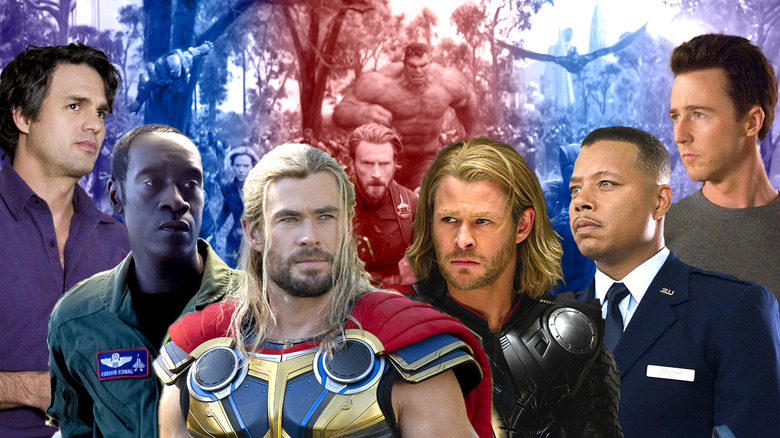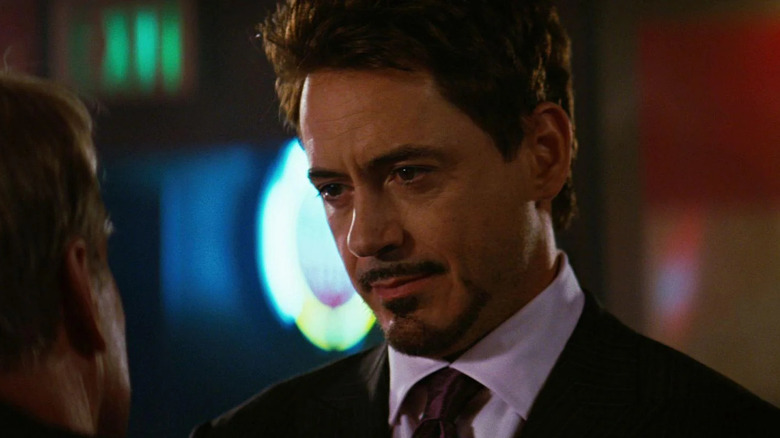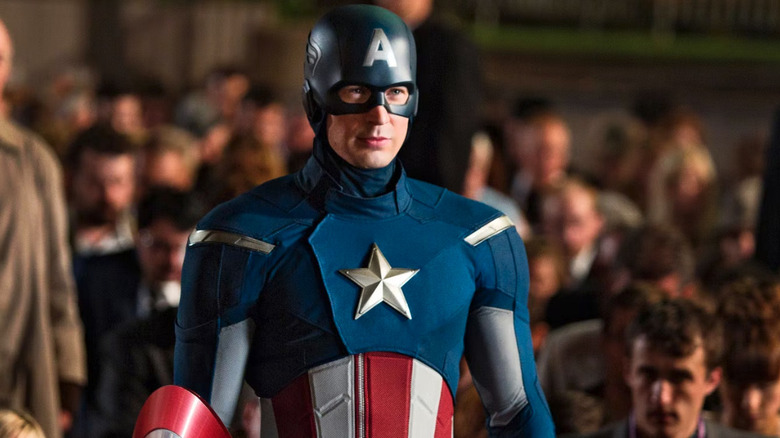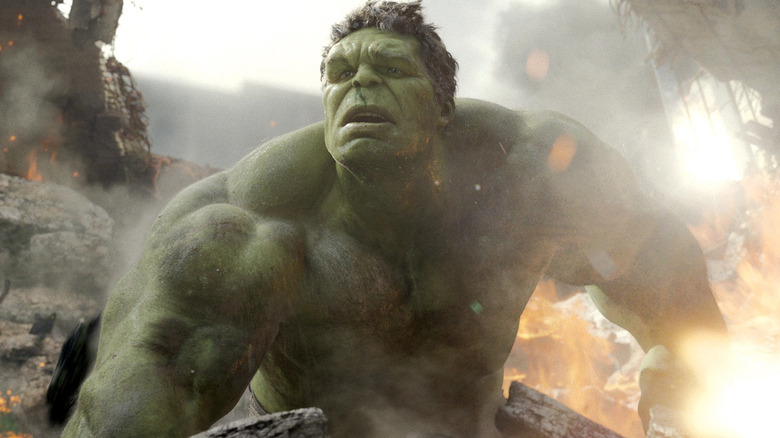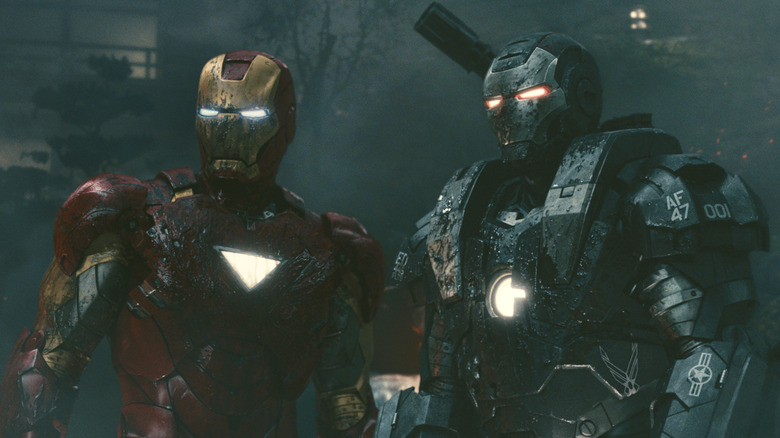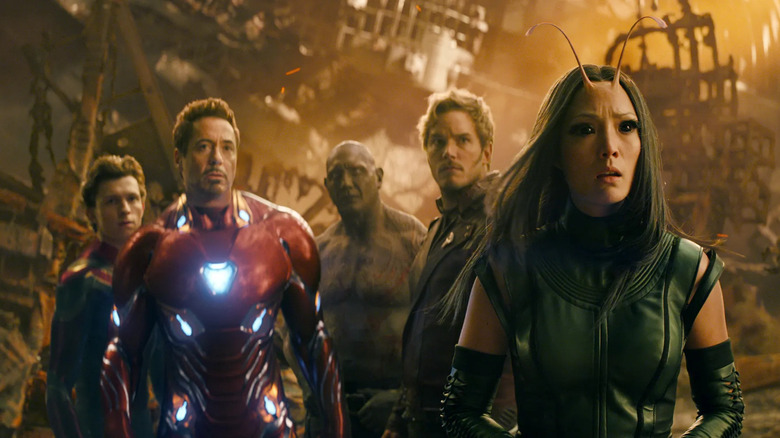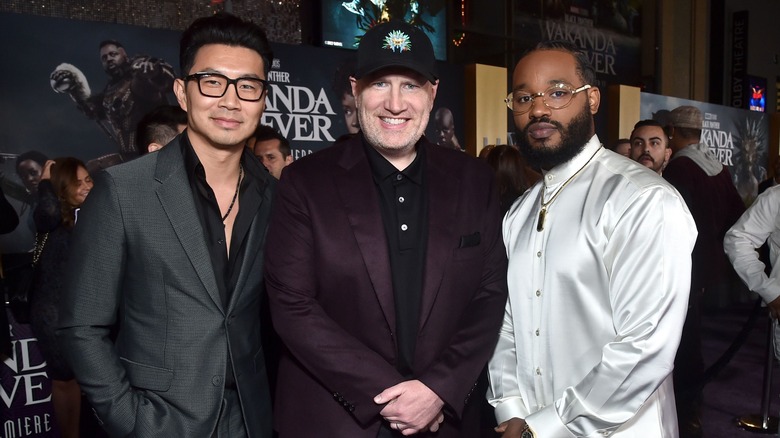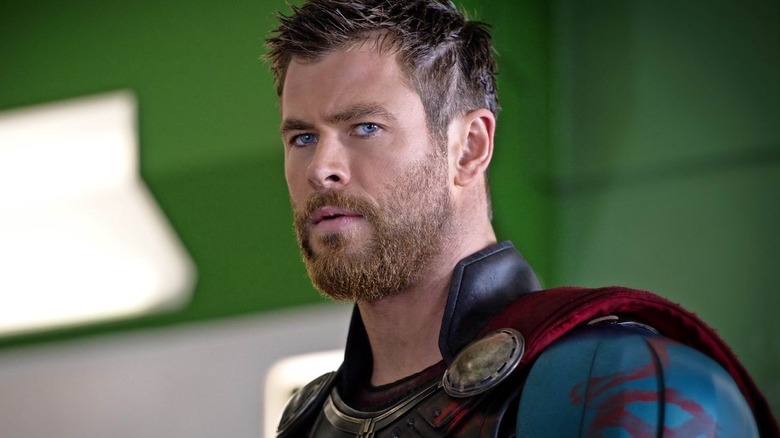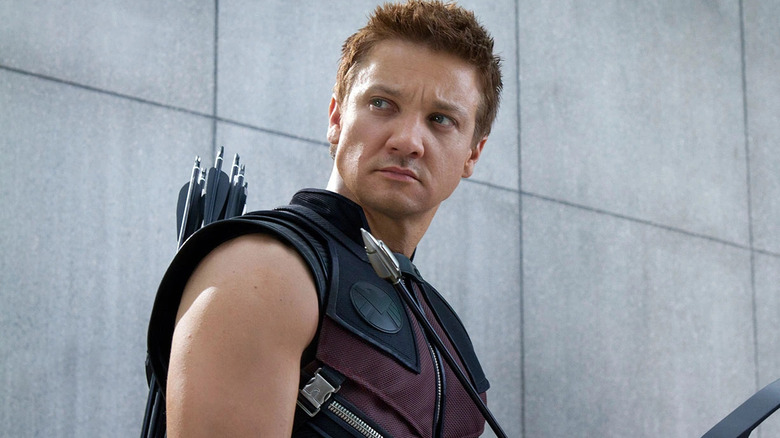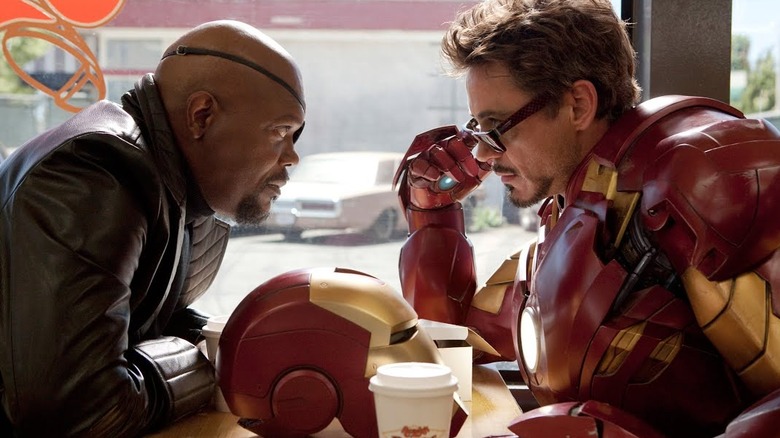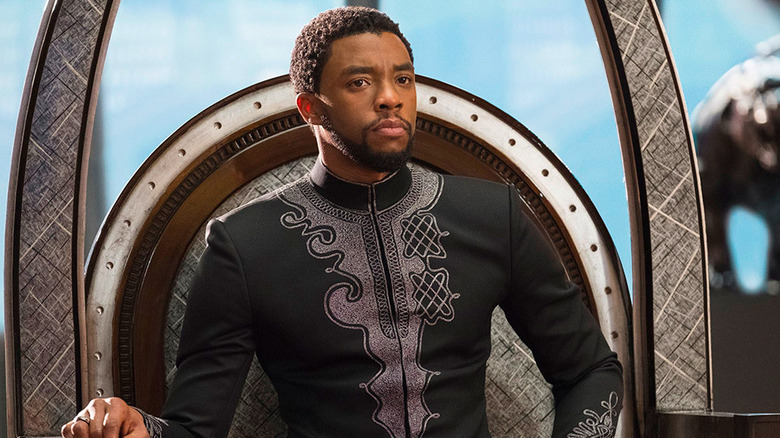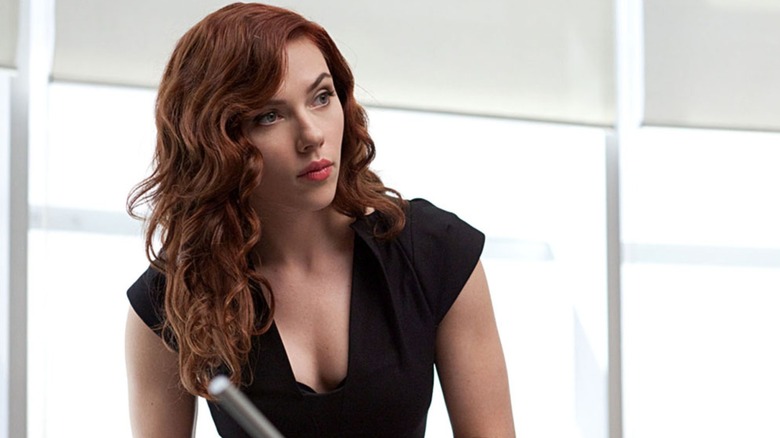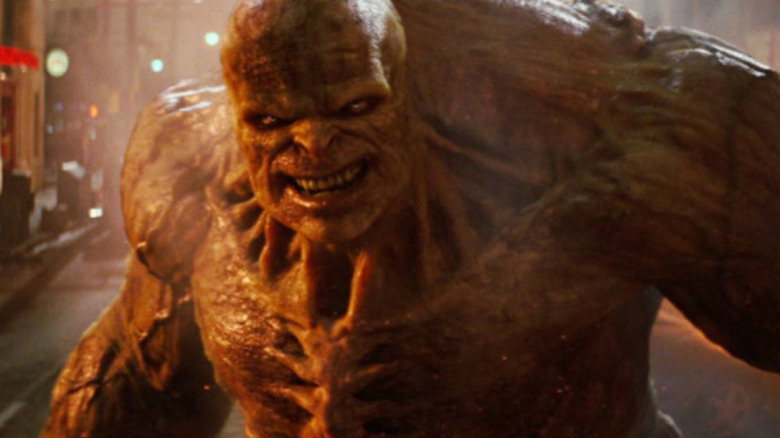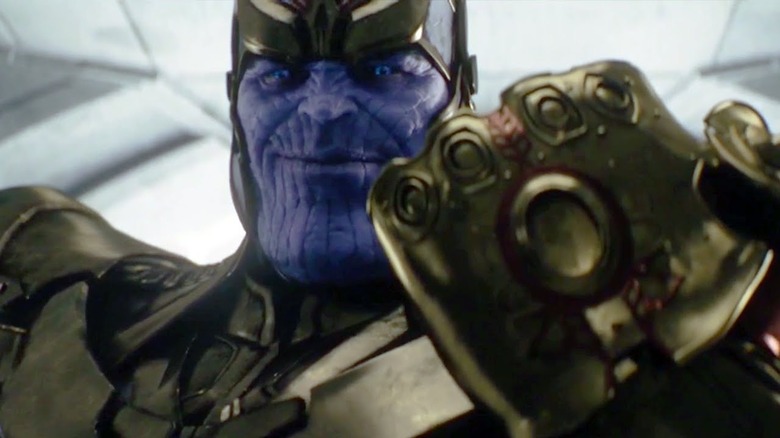13 Things The MCU Got Wrong In Phase 1 That It Corrected In Later Films
A cinematic universe is no simple undertaking. In the wake of the MCU reaching unprecedented levels of success, other rival studios learned this the hard way. But as many wins as Marvel has had — coming out strong with "Iron Man" and breaking box office records with a string of billion-dollar "Avengers" movies — it would be a mistake to assume it was all smooth sailing for them.
In fact, Marvel has faced many challenges on their way to cinematic glory. Though their debut film dropped jaws and raked in cash, their next three films weren't exactly whoppers at the ticket counter. Behind the scenes, they had struggles too, and not everything they did worked right out of the gate. While their first slate of movies was capped off with a team-up blockbuster, they made plenty of missteps along the way. But rather than sweep them under the rug, the studio course-corrected.
From casting decisions that didn't work out, to weakly written villains, and regrettable choices for its main roster of heroes, these are some of the mistakes Marvel made in Phase 1 of the MCU that they fixed in later movies.
Wait...who started the Avengers?
The interconnectivity of the MCU is precisely what makes it so special, but that doesn't mean it doesn't create its share of problems. In its very first year of existence, Marvel had their flagship hero Tony Stark make a cameo in a post-credits scene in their second film, "The Incredible Hulk" that confused everyone for years. In that scene, Stark approaches General Ross and makes a cryptic tease of the future "Avengers" film, claiming he's assembling a team of heroes.t
But questions instantly cropped up: was he offering Ross a spot on the team? Was he asking for Emil Blonsky, the villainous Abomination, to join the team? Was this setting up the Hulk to be the villain of "The Avengers" like the original comic's first storyline? It was all very vague, and if they hadn't fixed it by the time that "The Avengers" rolled around, it would have made even less sense. It proved such a messy mistake that Marvel decided to address it directly.
In a DVD release, Marvel included a short film titled "The Consultant" which saw S.H.I.E.L.D. agent Jasper Sitwell meeting with top agency brass. In their conversation — which sets it before the post-credits scene in "The Incredible Hulk" — it's implied that Stark's visit was merely a ploy to enrage General Ross and prevent the release of Blonsky from prison.
Cap's Avengers outfit
When the MCU debuted in 2008, one of the things that set it apart from previous comic book adaptations was its willingness to embrace its visual flare. The heroes sported colorful costumes that were more or less faithful to their designs in the comics. But that didn't mean they always got it right, and one of the worst was Captain America's costume in 2012's "Avengers."
Going from the more rugged look seen in "Captain America: The First Avenger" to a more form-fitting, brightly colored design may have seemed like the right idea on paper, but on-screen it just didn't work, and many fans cringed. Thankfully, with more appearances on the horizon, Marvel had the opportunity to fix it, and in his next appearance, "Captain America: The Winter Soldier," he donned a more well-thought-out costume — sometimes dubbed his "Stealth Suit" — while the climax saw him returning to the one worn in "The First Avenger."
In each subsequent film, Marvel continued to tweak Cap's costume, adding an "A" on the shoulders for "Avengers: Age of Ultron" and adding scale-mail like the comics in "Avengers: Endgame." No matter which outfit is your favorite for the Star Spangled hero, few will put his goofy-looking mess in the first "Avengers" near the top of the list.
The Hulk was a tough nut to crack
The Incredible Hulk may be one of the earliest Avengers, but he's always been a challenge to portray on screen. Hollywood seemed to find the right balance in the late '70s with "The Incredible Hulk" TV series that portrayed him as a misunderstood creature. But on film, it was a real challenge.
The 2003 Ang Lee-directed film, while it has its fans, struggled to balance the superhero adventure with human pathos and psycho-drama. When Marvel Studios tried again five years later, their attempt at a more straightforward action-adventure was met with mixed reviews. It seems the portrayal of Bruce Banner as a tormented soul, while compelling, didn't seem to appeal to audiences, while Ed Norton's complicated relationship with the studio didn't help matters.
Thankfully, after a recast — with actor Mark Ruffalo stepping into the role — and a complete redesign that ditched the lean muscle for bulky heft, it seemed Marvel got the jade giant on the right track in "The Avengers." Banner's alter ego serves as a brief foil to the team and becomes a key ally in their fight against Loki. Later, they'd finally figure out that the beastly version of the Hulk worked best as a supporting player, pairing him up with Thor in "Thor: Ragnarok," before transforming him into Smart Hulk for "Avengers: Endgame."
War Machine is more than just Iron Man Jr.
Another character that Marvel struggled to figure out in Phase 1 is James Rhodes aka War Machine. While actor Terrence Howard was replaced by Don Cheadle, the actor wasn't the problem, delivering an admirable performance in the first "Iron Man" film. The real issue with figuring out just how to showcase War Machine was that in Phase 1, he seemed more like a poor man's Iron Man rather than a strong hero in his own right.
In both "Iron Man" and "Iron Man 2" Rhodes isn't even portrayed as particularly loyal to Tony Stark: He steals the prototype Mark 2 armor and hands it over to the U.S. military in a dubiously not-quite-legal gambit that empowers the movie's villains. Though he does wind up fighting side by side with Stark, and did so again in "Iron Man 3," he never feels like a hero of his own in Phase 1. In fact, he can often come across as a less-skilled Iron Man despite having much more tactical acumen and years of military training.
In the "Avengers" films and beyond, however, Rhodes gets more agency of his own. He goes from being "Iron Man's Pal Jimmy Rhodes" to "War Machine: Battle-Tested Hero."
How not to make a movie...
The MCU has been an ambitious Hollywood experiment, attempting to interconnect multiple movie franchises into a sprawling big-screen saga. Overseeing it all from the beginning has been Kevin Feige, who had laid out release dates for a series of films in the summer of 2008, and was laser-focused on executing an intricate plan.
But then a writer's strike threw everything into chaos, and the lesser response to "Iron Man 2" and "The Incredible Hulk" left many wondering if the MCU was already in trouble. Though Feige was able to course-correct and land "The Avengers" to the biggest box office opening of all time, Phase 1 seems to have taught Feige and Marvel a few important lessons. For starters, they must have realized they couldn't rush into making movies, something they learned the hard way on the first "Iron Man," where the script was famously thrown out just as production began, forcing director Jon Favreau to write scenes on the day with his actors.
As a result, Feige learned not to be too locked into early decisions: He has shown no reluctance to delay later MCU offerings just because a release date had been announced. For example, the upcoming "Blade" and "Fantastic Four" films were pushed back after losing a pair of directors. There's also room for some on-the-fly changes in the movies too, leading to some of the best improvised moments in the MCU.
Relationships with talent
Over the years, Marvel has taken criticism for not giving their director's freedom, and early on there may have been some truth to that. Phase 1 saw some very real friction between Marvel and its talent, a fact best exemplified by their relationship with Edgar Wright, who'd been lined up to helm "Ant-Man" way back in 2006. But creative differences stalled the project until Wright walked away.
Likewise, "Iron Man" director Jon Favreau was so frustrated by his experience on the first two films in the series that he wrote, directed, and starred in "Chef," which was partially an allegory for his time working with the studio. At the same time, Marvel butted heads with actor Ed Norton on "Incredible Hulk," which may have led the studio to re-evaluate how they pick their talent. Rather than focus on the big name, Marvel seems to seek out directors who are willing to be the most collaborative.
In the process, unconventional choices like James Gunn, Taika Waititi, and the Russo Bros. have become some of Hollywood's most sought-after filmmakers. At the same time, Marvel has largely avoided the kinds of behind-the-scenes controversies that plagued them early on, while building a loyal stable of talent. Now, even when a director walks away, as Scott Derrickson did on "Doctor Strange 2," it's usually on good terms, and they're happy to consider a return.
How to use Thor
The Mighty Thor received his first feature film in 2011, a mix of space fantasy and epic Shakespearean drama. It received good reviews and a decent box office haul, but some remarked on Thor himself as a wooden hero who lacked charm, with Slate calling actor Chris Hemsworth "a generically pleasant slab of beefcake." The sequel, "Thor: The Dark World" was met with tepid reviews, with Thor again receiving criticism, and it seemed that maybe Marvel had bet wrong on the cosmic demi-god.
But perhaps that owed to the stunning success of "Guardians of the Galaxy" — that proved audiences craved a wacky cosmic adventure — Marvel reinvented Thor for his third solo installment. To that end, they brought in an entirely different kind of director: Taika Waititi for "Thor: Ragnarok," a more lighthearted action romp. Leaning into the inherent ridiculousness of a god from outer space, the film pivots Thor from a brooding, self-serious warrior to a colorful, snarky adventurer, pairing him up with The Incredible Hulk to create an epic buddy comedy — think a sci-fi "Lethal Weapon" — and it was one for the ages.
Ranking high on our list of best action-comedy movies of all time, "Thor: Ragnarok" gave new life to the character. Love it or hate it, Thor was now a hit with audiences, setting him off on a new direction in the MCU.
Hawkeye was given the shaft
In the comics, Hawkeye was one of the first new recruits into the Avengers after their first run of stories, arriving on the roster in "Avengers" #16 in 1965. In the MCU, he first pops up in "Thor" as the brooding, bow-wielding agent of SHIELD Clint Barton — played by actor Jeremy Renner — before becoming a member of the Avengers a year later. But many fans — and Renner himself — had a big problem with his portrayal in the 2012 team-up film, as Barton is mind-controlled for most of the film, and serves as a secondary villain of sorts.
Maybe this turn was inspired by the fact that Hawkeye had begun his career in the comics as a villain in the pages of "Tales of Suspense," but it's understandable if some audiences felt it wasted his heroic potential. Though he'd shine alongside the Avengers saving lives in the film's climax, it wouldn't be until Phase 2, and "Avengers: Age of Ultron" where he'd get to play a hero for good. But even in "Avengers: Infinity War" he'd get the shaft again, not even appearing.
In fact, it wouldn't be until Phase 4 that Marvel would truly correct this one, giving him his own series on Disney+. There, Renner would take the spotlight and become a mentor to a young hero named Kate Bishop.
Relax on the world-building
Perhaps because they weren't sure if their cinematic universe gambit would pay off, the first "Iron Man" film feels like a standalone story in its own world. Sure, there are hints at a larger tapestry — such as the presence of Phil Coulson — but Marvel wisely kept the tease for "The Avengers" until the post-credits scene so as not to intrude on the origin story they were telling. But after it landed big box office bucks the sequel doubled down, perhaps to its detriment, loading the story with subplots and characters that connected to various dots around the nascent MCU.
Instead of a story laser-focused on Tony Stark, "Iron Man 2" features S.H.I.E.L.D. agent Natasha Romanoff shadowing the armored playboy, while Nick Fury barges into a couple of scenes to have his say. Some felt this was a distraction, and criticized Marvel for getting bogged down in world-building, putting too much attention into setting up the next big movie rather than trying to make the movie that was in front of them.
In later phases, however, Marvel found a better balance. Sure, they still teased future sequels, spin-offs, and team-ups in their solo films. But now, they didn't get in the way of the story at hand, because by Phase 2, Marvel understood that audiences were in it for the long haul and didn't need to be handheld from one movie to the next.
A lack of diversity
Looking back with the benefit of hindsight, it can be hard not to miss that the first few phases of the MCU weren't really all that diverse. Between "Iron Man," "Thor," "Captain America," and "The Incredible Hulk," every solo Marvel adventure in Phase 1 was focused on a brawny white man. Even among the roster of "The Avengers," only Black Widow offered something different. Despite the comics on which their movies were based being filled with heroes of all different ethnic and racial backgrounds, as well as plenty of powerful women heroes, Marvel seemed to be ignoring them almost entirely.
All of that would change by Phase 3, however. In 2018, Marvel at long last gave one of its most popular Black characters his own franchise, as "Black Panther" landed in February of that year and became a billion-dollar blockbuster. A year later, "Captain Marvel" led by Brie Larson did the same as the first solo movie for a Marvel super-heroine. "Black Widow" finally got her own movie in 2021 too, proving diversity was a strength of the studio's output.
Today, there is no shortage of representation in the MCU, from Pakistani-American teen Kamala Khan in "Ms. Marvel," Chinese-Canadian actor Simu Liu headlining "Shang-Chi and the Legend of the Ten Rings," and Sam Wilson became their first Black Captain America on-screen. Why it took them quite so long to get to that point, however, is frankly a mystery.
Sexism and misogyny
"Iron Man 2" introduced Black Widow into the MCU, played by Scarlett Johansson. While she did represent a small step towards diversifying the roster of heroes, Natasha Romanoff was sadly used as little more than something for boys to leer at in her early appearances, which became a common criticism of Phase 1. And it wasn't just fans and professional critics who voiced that opinion, with Johansson herself later expressing discomfort with how she was objectified on-screen.
"While ["Iron Man 2"] was really fun and had a lot of great moments... the character is like, so sexualized," Johansson told HelloBeautiful. "[They] talked about like, she's like a piece of something and like a possession. I think Tony even says something like that," the actress said, referring to a line in the film where Stark says "I want one," when referring to her character. This portrayal sadly continued into "Avengers" films and even past Phase 1, with "Age of Ultron" including a scene where Bruce Banner falls comedically onto Johansson's breasts.
Thankfully, this regrettable element has improved, with the likes of "Captain Marvel" and even Johansson's own "Black Widow" being praised for their portrayal of tough, female leads. The likes of "Ms. Marvel," "She-Hulk," and "WandaVision" too have done much for women in the MCU, illustrating that Marvel doesn't need to turn their female heroes into eye candy to make them popular.
Cookie cutter villains
The MCU, while an overwhelming success, has had its share of criticisms. One of the biggest in Phase 1 was its lack of truly compelling villains. This was quite the difference from previous comic book movies like "Batman" or "X-Men," where the bad guys were often the best characters in the film. But while Marvel rightly put the focus on its heroes, it sometimes led to some cookie-cutter villains. Still, it was hard not to notice that the likes of Abomination, Iron Monger, the Destroyer, and Anton Vanko often felt like perfunctory parts rather than fascinating characters in their own right.
But while Phase 2 films like "Thor: The Dark World," "Ant-Man," and "Iron Man 3" didn't do much better, things took a turn beginning with "Captain America: The Winter Soldier." The twisted, brainwashed Bucky Barnes was a far cry from the caricature that was Red Skull, while Phase 3 villains like Ego, The Vulture, and Yon-Rogg showed that Marvel had perhaps learned valuable lessons. And let's not forget that one of the biggest strengths of "Black Panther" was indeed its villain, Erik Killmonger. While there are still some villains who fail to pass muster, it's no coincidence that the top 10 villains on our list of best baddies in the MCU almost all hail from outside Phase 1.
Thanos
Sure, Phase 1 of its MCU had a bit of a villain problem, but after some flat, uninteresting antagonists like Red Skull and Whiplash, fans were probably pleased that it would be Loki — the best villain of the bunch — to face off with the super-team in "The Avengers." But in addition to dropping jaws in the final scene, the cosmic despot Thanos may have also been cause for fans to worry that they'd get Marvel's biggest bad all wrong. In that post-credits scene, Thanos is a wonky-looking, cardboard cutout of a dastardly comic book space tyrant.
Admittedly, we don't get much of Thanos in Phase 1, and Marvel was smart to just tease him with a single scene where he speaks no words at all. Because the makers of the MCU clearly weren't sure how best to portray him, as evidenced by his lackluster appearance in Phase 2's "Guardians of the Galaxy," where he again comes across again as a cliched evil boss. Marvel knew they had to fix it, and so they did.
In "Avengers: Infinity War," Marvel got it right, with a tragic backstory, a pitch-perfect performance from actor Josh Brolin, and some of the most impressive CGI in Hollywood history. As far as fixes go, it doesn't get more impressive than the on-screen evolution of Thanos.
